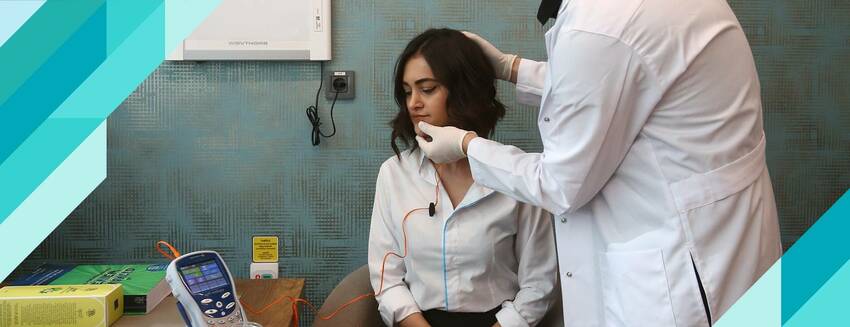- E-Magazine
Contents
Difficulty in swallowing (dysphagia), which occurs when liquid and solid food cannot be taken into the mouth or when the food taken into the mouth cannot be safely delivered to the stomach, not only reduces the quality of life but also brings many health problems. Dysphagia, which causes many problems such as water and weight loss, lung diseases, poor oral hygiene, opening the windpipe from the throat, feeding through the nose or stomach, can also cause the death of the patient. Stating that swallowing disorders can be treated with oral-motor rehabilitation, Assoc. Prof. Dr. Çetin Sayaca pointed out that dysphagia can be seen in people of all ages.
Specialist Physiotherapist Assist. Assoc. Prof. Dr. Çetin Sayaca from Üsküdar University NP Feneryolu Medical Center gave important information about swallowing disorders and treatment methods.
Dysphagia brings health problems
"Dysphagia (dysphagia) is the inability to take liquid or solid food into the mouth or the inability to safely deliver the food taken into the mouth to the stomach due to anatomical, physiological and psychological problems," said Asst. Assoc. Prof. Dr. Çetin Sayaca,
"Swallowing disorder can lead to dehydration, weight loss, lung diseases, poor oral hygiene, opening of the windpipe from the throat, feeding through the nose or stomach, deterioration in quality of life, increase in health costs, as well as death of the patient. Dysphagia can occur in people of all ages. It is more common in individuals with neurological diseases and head and neck cancer. However, dysphagia is encountered even in individuals aged 60 and over without any disease."
What are the symptoms of dysphagia?
Assist. Assoc. Prof. Dr. Çetin Sayaca listed the symptoms of dysphagia as follows:
- "Recurrent lung diseases,
- Frequent fever with no known cause,
- Don't put too much effort into eating,
- Prolonged eating time,
- Sticking / residual sensation in the throat,
- Cough after swallowing,
- Voice change after swallowing,
- Changing eating habits,
- Avoidance of drinking water and reduced consumption,
- Prolonged amount and duration of swallowing,
- The need to clear the throat after swallowing,
- Fatigue after eating and/or drinking,
- Weight loss after malnutrition."
Treatment of dysphagia is possible with "oral-motor rehabilitation"!
Assist. Assoc. Prof. Dr. Çetin Sayaca said, "The oral-motor rehabilitation program is determined according to the results of the evaluation, the severity of the disease, the expectations of the patients and the current treatment methods. Therefore, the content and duration of treatment varies from patient to patient."
Which applications are included in the oral-motor rehabilitation program?
In the oral-motor rehabilitation program;
-Ensuring safe swallowing by changing the way of feeding,
-Postural techniques to ensure safe swallowing and maintenance of nutrition,
-Protecting the respiratory system and ensuring swallowing with swallowing maneuvers,
-Thermal tactile stimulation,
-Exercise programs for the muscles responsible for swallowing,
-Proprioceptive neuromuscular facilitation techniques,
-Motor learning strategies,
-Neuromuscular electrical stimulation (vitalstim etc.),
-Cardiopulmonary rehabilitation (with KPET device),
-Muscular strength training (with Isomed 2000 isokinetic device),
- Joint and soft tissue mobilization techniques,
- There are taping (kinesiotape®, mcconnell etc.) applications.
The aim is to enable patients to return to their daily lives
"Our aim with oral-motor rehabilitation is to ensure that our patient can return to his/her daily life in a healthy way," said Assoc. Prof. Dr. Çetin Sayaca, Specialist Physiotherapist from Üsküdar University NP Feneryolu Medical Center:
"Our most important goal is to ensure swallowing and oral nutrition. Depending on the severity of the disease, in cases where safe swallowing does not occur, safe feeding methods are taught to prevent food from escaping into the lungs and the problems that may arise as a result. With oral-motor rehabilitation, we aim to enable the patient to return to life independently."








